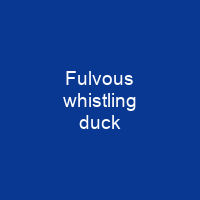The Fulvous Whistling Duck: A Mysterious Beauty in the Avian World
Imagine a bird that combines the elegance of a swan with the grace of a duck—this is the fulvous whistling duck, a species that captivates nature enthusiasts and scientists alike. With its rich buff plumage and distinctive whistling calls, this bird stands out in the vast avian world.
Physical Characteristics: A Meticulously Crafted Design
The fulvous whistling duck is a marvel of nature’s design. Its reddish-brown feathers, long legs, and grey bill create a striking contrast against its environment. The wingspan ranges from 85 to 93 cm, allowing it to soar gracefully through the skies. But what truly sets this bird apart are its unique features: the whitish stripes on its flanks, the long grey bill, and the dark stripe running down its neck.
Behavioral Traits: A Social and Noisy Flock
These ducks are not just visually stunning; they are also incredibly social. They form large flocks that can be heard whistling loudly on the ground or in flight, creating a symphony of sounds that echo through wetlands and marshes. Their calls are so distinct that even in adult males and females, there is 100% accuracy in sexing based on acoustic analysis.
Nesting Habits: A Nest Built for Survival
When it comes to nesting, the fulvous whistling duck shows remarkable adaptability. It builds its nest in dense vegetation or tree holes, laying around ten whitish eggs that hatch after 24-29 days. Both parents take turns incubating and caring for the young until they fledge at nine weeks. This level of parental care ensures the survival of the next generation.
Feeding Habits: A Versatile Diet
The fulvous whistling duck is a versatile feeder, consuming a mix of plant and animal material. It forages by picking plant items while walking or swimming, upending to reach deeper water, and even diving to up to 1 m depth. Its diet includes seeds, bulbs, grasses, stems, and occasionally small animals. This adaptability allows it to thrive in various environments.
Range and Habitat: A Global Presence
The fulvous whistling duck has a large range extending across four continents—South America, Africa, Asia, and even parts of North America. It breeds in lowland marshes and swamps, often found in open rice fields and flat country. While it avoids wooded areas, it can be seen at altitudes up to 300 m (980 ft) in Venezuela and as high as 4,080 m (13,390 ft) in Peru.
Conservation Status: A Species of Least Concern
Despite facing threats such as hunting and pesticide use, the fulvous whistling duck is classified as a species of least concern by the International Union for Conservation of Nature. With an estimated population of 2.12 million (with a range of 1.3-1.5 million), it has managed to expand into new territories like the West Indies and southern US, even being introduced to Cuba and Florida in the late 1960s.
Challenges and Threats: A Complex Existence
While the fulvous whistling duck has a wide range, it is not without its challenges. Hunting and persecution are ongoing issues, while pesticides used in rice fields can harm their health. However, these ducks have shown remarkable resilience, adapting to new environments and continuing to thrive.

As we continue to explore and understand the fulvous whistling duck, one cannot help but marvel at its beauty and resilience. This bird serves as a reminder of nature’s incredible diversity and the importance of conservation efforts to protect these magnificent creatures.
The fulvous whistling duck is more than just a bird; it is a symbol of adaptability, survival, and the enduring spirit of life in the wild. Its story teaches us that even in the face of challenges, nature finds ways to thrive and flourish. Let us continue to learn from these remarkable creatures and work towards preserving their habitats for generations to come.
You want to know more about Fulvous whistling duck?
This page is based on the article Fulvous whistling duck published in Wikipedia (retrieved on November 28, 2024) and was automatically summarized using artificial intelligence.







